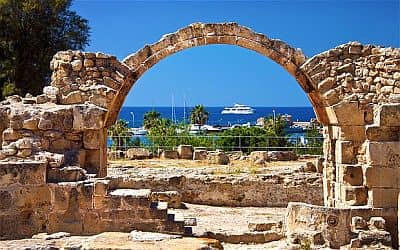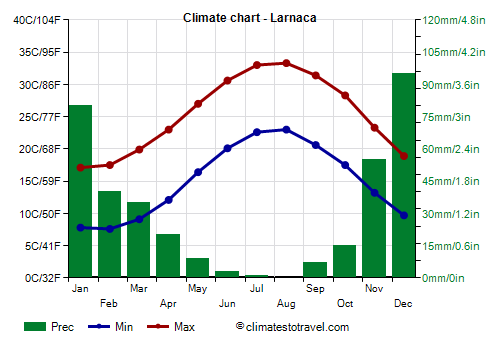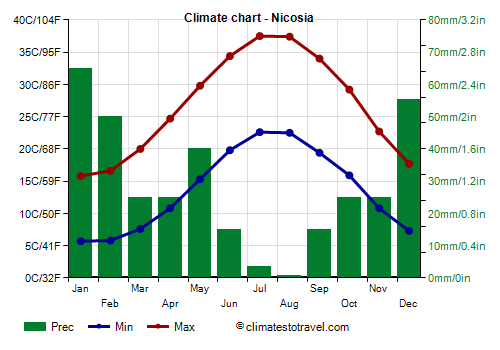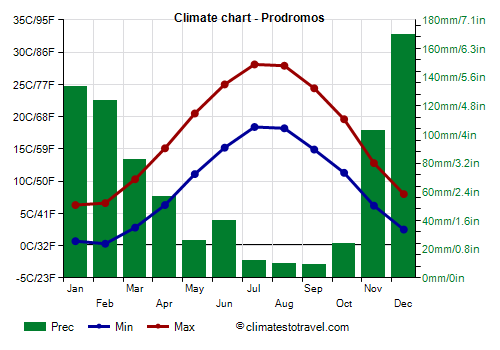Select units of measurement for the temperature and rainfall tables (metric or imperial).
Average weather, temperature, rainfall, sunshine
Cyprus has a
Mediterranean climate along the coast, with mild and rainy winters and hot and sunny summers, while in the inland plain of Nicosia the climate is hotter in summer. In the mountainous areas, the climate is obviously colder.
The sky is almost always clear in the long summer, but the
sun shines for a good number of hours even in winter.
The
sea in Cyprus is warm enough for swimming from June to October. In winter, it is a bit cold, though it doesn't drop below 17 °C (63 °F).
The climate in detail
The coast
Along the
coast, the climate is typically Mediterranean, with average daily temperatures in January around 12 degrees Celsius (54 °F). Rainfall is not abundant, about 350/400 millimeters (14/16 inches) per year in cities like Larnaca and Limassol, and most of the rainfall occurs from November to March, with a peak in December and January.
In winter, periods of bad weather, sometimes even a bit cold, alternate with periods of good weather, when the sun shines.

Summer along the coast is long, since it runs from late May to early October, and it's hot and sunny, a little muggy but also tempered by steady breezes. In general, along the coasts, it never rains for a long period, from June to September, during which the sun always shines.
Larnaca

In
Larnaca, located on the south-eastern coast, the average temperature ranges from 12.5 °C (54.5 °F) in January and February to 28 °C (82.5 °F) in July and August.
As mentioned, the rains on the coast follow the Mediterranean pattern and are not abundant, although they can occasionally be heavy in winter. In Larnaca, 355 mm (14 in) of rain falls per year, with a maximum in December and January.
Interior
Nicosia

In the
Mesaoria Plain, winter is still mild, but it's slightly colder: the average temperature in January is about 10 °C (50 °F), and the temperature at night can drop to around freezing.
Summer is very hot, so much so that in the capital,
Nicosia, highs are about 37 °C (99 °F) in July and August. The presence of such a hot area makes Cyprus the hottest island of the Mediterranean. During heat waves from Africa, the temperature in Nicosia can reach or exceed 40 °C (104 °F) from May to October. In 2020, the temperature reached 43 °C (109.5 °F) in mid-May and 45 °C (113 °F) in early September.
The rainfall pattern is similar to that of the coast: in Nicosia, average annual precipitation is about 340 mm (13.5 in), with a maximum in winter, from December to February, while it hardly ever rains in summer.
Prodromos

The reason why in Nicosia the summer is so hot, lies in the fact that the plain where it is located is locked between two chains of
mountains, which hinder sea breezes: in the north lies the chain of Kyrenia (or Girne), while in the south, namely in the central part of the island, lie the
Troodos Mountains, culminating in Mount Olympus, 1,952 meters (6,404 feet) high. There is also a ski lift for winter sports. The two mountain ranges have a greener landscape and are covered by forests.
In
Prodromos, located at the foot of Mount Olympus, at 1,300 meters (4,250 feet) meters above sea level, the average temperature is 3.5 °C (38.5 °F) in January and February, while it is around 23 °C (73.5 °F) in July and August.
Here, precipitation amounts to 800 mm (31.5 in) per year, and in winter, when it can also snow and freeze, it is abundant. In summer, rare thundershowers can sometimes occur.
When to go
If you want to visit the
cities of Cyprus, the Greco-Roman ruins as well as the Byzantine monasteries, the best periods are
spring and autumn, and in particular, from mid-April to mid-May and from mid-October to mid-November, when you can find daytime temperatures around 20/25 °C (68/77 °F), with cool nights, sometimes a bit cold in the plain of Nicosia; sometimes, however, it can rain.
Spring is more advisable because it has longer days, and also because nature in this period is in bloom. By choosing these two periods, you can avoid the summer heat, and this applies especially for the plain of Nicosia, where the summer heat is often intense.
For a
beach holiday, you can go from mid-May to mid-October, even though the sea is still cool in May.
As a compromise, it is possible to combine excursions with some moments of relaxation at the beach, for example in
June and September, remembering that it can get hot, especially away from the coast.
What to pack
In
winter: bring spring/autumn clothes, a sweater, a jacket, and a raincoat or umbrella. For the mountains, bring warm clothes, such as a down jacket and a hat.
In
summer: bring light clothing, sunscreen, a sun hat, a light sweatshirt for the evening, and a scarf for the breeze. For the mountains, bring a sweatshirt or sweater, a light jacket, and hiking shoes.
Climate data - Cyprus
| Famagusta |
|---|
|
| Jan | Feb | Mar | Apr | May | Jun | Jul | Aug | Sep | Oct | Nov | Dec |
|---|
| Min temp. | 8 | 8 | 10 | 12 | 17 | 21 | 24 | 24 | 22 | 17 | 13 | 10 |
|---|
| Max temp. | 17 | 18 | 20 | 23 | 27 | 31 | 34 | 34 | 32 | 28 | 23 | 19 |
|---|
| Precip. | 85 | 40 | 30 | 20 | 15 | 0 | 0 | 0 | 5 | 30 | 55 | 75 |
|---|
|
|
|
|
| Sea temp | 18 | 17 | 17 | 18 | 21 | 24 | 27 | 28 | 28 | 25 | 22 | 20 |
|---|
| Larnaca |
|---|
|
| Jan | Feb | Mar | Apr | May | Jun | Jul | Aug | Sep | Oct | Nov | Dec |
|---|
| Min temp. | 8 | 8 | 9 | 12 | 16 | 20 | 23 | 23 | 21 | 18 | 13 | 10 |
|---|
| Max temp. | 17 | 18 | 20 | 23 | 27 | 31 | 33 | 33 | 31 | 28 | 23 | 19 |
|---|
| Precip. | 80 | 40 | 35 | 20 | 10 | 5 | 0 | 0 | 5 | 15 | 55 | 95 |
|---|
| Prec. days | 8 | 6 | 5 | 3 | 1 | 0 | 0 | 0 | 1 | 2 | 5 | 8 |
|---|
|
|
| Sun hours | 6 | 7 | 8 | 9 | 11 | 13 | 13 | 12 | 10 | 9 | 7 | 6 |
|---|
| Sea temp | 18 | 17 | 17 | 18 | 21 | 24 | 27 | 28 | 27 | 25 | 22 | 20 |
|---|
| Limassol |
|---|
|
| Jan | Feb | Mar | Apr | May | Jun | Jul | Aug | Sep | Oct | Nov | Dec |
|---|
| Min temp. | 9 | 8 | 10 | 13 | 17 | 20 | 22 | 23 | 21 | 18 | 14 | 10 |
|---|
| Max temp. | 18 | 18 | 20 | 23 | 27 | 31 | 33 | 33 | 31 | 29 | 24 | 19 |
|---|
| Precip. | 85 | 65 | 35 | 20 | 5 | 0 | 0 | 0 | 5 | 15 | 80 | 100 |
|---|
| Prec. days | 9 | 7 | 6 | 3 | 1 | 0 | 0 | 0 | 0 | 2 | 6 | 9 |
|---|
|
|
| Sun hours | 6 | 8 | 8 | 9 | 11 | 13 | 13 | 12 | 10 | 9 | 8 | 6 |
|---|
| Sea temp | 18 | 17 | 17 | 18 | 21 | 24 | 27 | 28 | 27 | 25 | 22 | 20 |
|---|
| Nicosia |
|---|
|
| Jan | Feb | Mar | Apr | May | Jun | Jul | Aug | Sep | Oct | Nov | Dec |
|---|
| Min temp. | 6 | 6 | 8 | 11 | 15 | 20 | 23 | 22 | 19 | 16 | 11 | 7 |
|---|
| Max temp. | 16 | 17 | 20 | 25 | 30 | 34 | 38 | 37 | 34 | 29 | 23 | 18 |
|---|
| Precip. | 65 | 50 | 25 | 25 | 40 | 15 | 5 | 0 | 15 | 25 | 25 | 55 |
|---|
| Prec. days | 7 | 6 | 5 | 4 | 3 | 1 | 0 | 0 | 1 | 3 | 5 | 8 |
|---|
|
|
| Sun hours | 6 | 7 | 8 | 9 | 11 | 12 | 12 | 12 | 10 | 9 | 7 | 6 |
|---|
|
| Paphos |
|---|
|
| Jan | Feb | Mar | Apr | May | Jun | Jul | Aug | Sep | Oct | Nov | Dec |
|---|
| Min temp. | 9 | 8 | 10 | 12 | 15 | 18 | 21 | 22 | 20 | 17 | 13 | 10 |
|---|
| Max temp. | 17 | 18 | 19 | 22 | 25 | 28 | 30 | 31 | 29 | 27 | 23 | 19 |
|---|
| Precip. | 90 | 60 | 35 | 15 | 10 | 0 | 0 | 0 | 5 | 20 | 60 | 100 |
|---|
|
|
|
| Sun hours | 6 | 7 | 8 | 9 | 11 | 12 | 12 | 11 | 10 | 9 | 7 | 6 |
|---|
| Sea temp | 18 | 17 | 17 | 18 | 21 | 24 | 27 | 28 | 27 | 25 | 22 | 20 |
|---|
| Prodromos (1,300 meters) |
|---|
|
| Jan | Feb | Mar | Apr | May | Jun | Jul | Aug | Sep | Oct | Nov | Dec |
|---|
| Min temp. | 1 | 0 | 3 | 6 | 11 | 15 | 18 | 18 | 15 | 11 | 6 | 2 |
|---|
| Max temp. | 6 | 7 | 10 | 15 | 20 | 25 | 28 | 28 | 24 | 20 | 13 | 8 |
|---|
| Precip. | 135 | 125 | 80 | 55 | 25 | 40 | 10 | 10 | 10 | 25 | 100 | 170 |
|---|
| Prec. days | 12 | 11 | 10 | 7 | 4 | 2 | 1 | 1 | 1 | 4 | 7 | 11 |
|---|
|
|
| Sun hours | 4 | 5 | 6 | 8 | 9 | 10 | 11 | 10 | 8 | 7 | 6 | 4 |
|---|
|
See also the
temperatures month by month